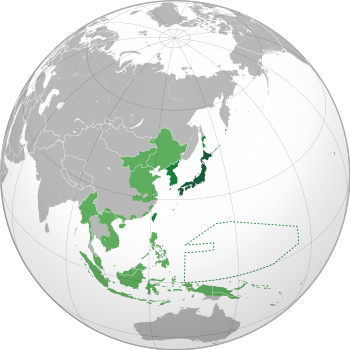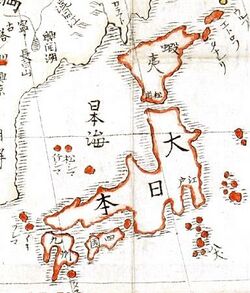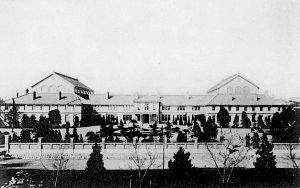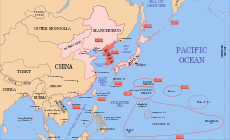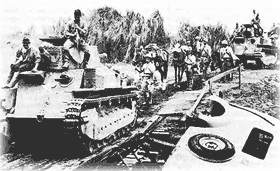امبراطورية اليابان
| |||||||||||||||
| |||||||||||||||
| |||||||||||||||
امبراطورية اليابان (大日本帝国/大日本帝國, Dai Nippon Teikoku, حرفياً "الامبراطورية اليابانية العظمى")[7]، هي ملكية دستورية شبه برلمانية، امبراطورية، وقوة عالمية كانت موجودة منذ استعراش مـِيـْجي في 3 يناير 1868 حتى سن دستور 1947 لليابان المعاصرة.[5]
. . . . . . . . . . . . . . . . . . . . . . . . . . . . . . . . . . . . . . . . . . . . . . . . . . . . . . . . . . . . . . . . . . . . . . . . . . . . . . . . . . . . . . . . . . . . . . . . . . . . . . . . . . . . . . . . . . . . . . . . . . . . . . . . . . . . . . . . . . . . . . . . . . . . . . . . . . . . . . . . . . . . . . . .
استعراش مـِيـْجي

حرب بوشين

القسم الخماسي
فترة مـِيـْجي (1868–1912)
Saigō Takamori, one of the most influential samurai in Japanese history
Emperor Meiji, the 122nd emperor of Japan
The mission major member. Left to right : Kido Takayoshi, Yamaguchi Masuka, Iwakura Tomomi, Itō Hirobumi, Ōkubo Toshimichi
Merchant Thomas Blake Glover was a British merchant in Bakumatsu and received Japan's second highest order from Emperor Meiji in recognition of his contributions to Japan's industrialization.
الدستور
الدايت الامبراطوري
التنمية الاقتصادية

الحرب الصينية اليابانية الأولى
ثورة الملاكمين
الحرب الروسية اليابانية

. . . . . . . . . . . . . . . . . . . . . . . . . . . . . . . . . . . . . . . . . . . . . . . . . . . . . . . . . . . . . . . . . . . . . . . . . . . . . . . . . . . . . . . . . . . . . . . . . . . . . . . . . . . . . . . . . . . . . . . . . . . . . . . . . . . . . . . . . . . . . . . . . . . . . . . . . . . . . . . . . . . . . . . .
ضم كوريا
| كوريا، 1910–1945 | |
|---|---|
| كوريا في الامبراطورية اليابانية 1939 | |
| خط زمني | |
| معاهدة الحماية اليابانية-الكورية | 18 نوفمبر 1905 |
| ضم اليابان | 22 أغسطس 1910 |
| حركة 1 مارس | 1 مارس 1919 |
| Battle of Qingshanli | 11 سبتمبر 1920 |
| حادث ساكورادامون | 9 يناير 1932 |
| هجوم قصف شنگهاي | 29 أبريل 1932 |
| Sōshi-kaimei | 1940–1945 |
| انتهاء الحرب العالمية الثانية | 15 أغسطس 1945 |
| Victory over Japan Day | 2 سبتمبر 1945 |
| تقسيم كوريا | 1945 |
فترة تايشو (1912–1926)
الحرب العالمية الأولى

التدخل السيبيري

"ديمقراطية تايشو"
شووا المبكرة (1926–1937)

توسع الديمقراطية
التنظيمات العسكرية والاجتماعية
العوامل القومية

العوامل الاقتصادية

شووا المتأخرة (1937–1947) – التوسعية
. . . . . . . . . . . . . . . . . . . . . . . . . . . . . . . . . . . . . . . . . . . . . . . . . . . . . . . . . . . . . . . . . . . . . . . . . . . . . . . . . . . . . . . . . . . . . . . . . . . . . . . . . . . . . . . . . . . . . . . . . . . . . . . . . . . . . . . . . . . . . . . . . . . . . . . . . . . . . . . . . . . . . . . .
التوسعية قبل الحرب
منشوريا
الحرب الصينية اليابانية الثانية
الاشتباكات مع الاتحاد السوڤيتي
الاتفاق الثلاثي


حرب المحيط الهادي
 مقالة مفصلة: حرب المحيط الهادي
مقالة مفصلة: حرب المحيط الهادي
الهجوم على پيرل هاربر
 مقالة مفصلة: الهجوم على پيرل هاربر
مقالة مفصلة: الهجوم على پيرل هاربر
الهجمات اليابانية (1941–42)
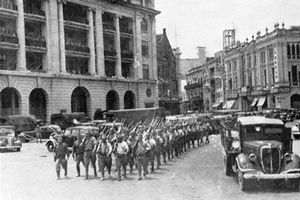
مسار الهزيمة (1942–45)


الغارات الجوية على اليابان

معاودة دخول الاتحاد السوڤيتي
الهزيمة والاستسلام
بعد الحرب العالمية الثانية
احتلال اليابان
اعادة التقسيم
جرائم الحرب

شخصيات مؤثرة
سياسية


عسكرية
خط زمني
- 1926: Emperor Taishō dies (December 25).
- 1927: Tanaka Giichi becomes prime minister (April 20).
- 1928: Emperor Shōwa is formally installed as emperor (November 10).
- 1929: Osachi Hamaguchi becomes prime minister (July 2).
- 1930: Hamaguchi is wounded in an assassination attempt (November 14).
- 1931: Hamaguchi dies and Wakatsuki Reijirō becomes prime minister (April 14). Japan occupies Manchuria after the Mukden Incident (September 18). Inukai Tsuyoshi becomes prime minister (December 13) and increases funding for the military in China.
- 1932: After an attack on Japanese monks in Shanghai (January 18), Japanese forces shell the city (January 29). Manchukuo is established with Henry Pu Yi as emperor (February 29). Inukai is assassinated during a coup attempt and Saitō Makoto becomes prime minister (May 15). Japan is censured by the League of Nations (December 7).
- 1933: Japan leaves the League of Nations (March 27).
- 1934: Keisuke Okada becomes prime minister (July 8). Japan withdraws from the Washington Naval Treaty (December 29).
- 1936: Coup attempt (February 26 Incident). Kōki Hirota becomes prime minister (March 9). Japan signs its first pact with Germany (November 25) and occupies Tsingtao (December 3). Mengjiang established in Inner Mongolia.
- 1937: Senjūrō Hayashi becomes prime minister (February 2). Prince Fumimaro Konoe becomes prime minister (June 4). Battle of Lugou Bridge (July 7). Japan captures Beijing (July 31). Japanese troops occupy Nanjing (December 13), beginning the Nanjing Massacre.
- 1938: Battle of Taierzhuang (March 24). Canton falls to Japanese forces (October 21).
- 1939: Hiranuma Kiichirō becomes prime minister (January 5). Abe Nobuyuki becomes prime minister (August 30).
- 1940: Mitsumasa Yonai becomes prime minister (January 16). Konoe becomes prime minister for a second term (July 22). Hundred Regiments Offensive (August–September). Japan occupies Indochina in the wake of the fall of Paris, and signs the Tripartite Pact (September 27).
- 1941: General Hideki Tōjō becomes prime minister (October 18). Japanese naval forces attack Pearl Harbor, Hawaii (December 7), prompting the United States to declare war on Japan (December 8). Japan conquers Hong Kong (December 25).
- 1942: Battle of Ambon (January 30 – February 3). Battle of Palembang (February 13–15). Singapore surrenders to Japan (February 15). Japan bombs Australia (February 19). Indian Ocean raid (March 31 – April 10). Doolittle Raid on Tokyo (April 18). Battle of the Coral Sea (May 4–8). U.S. and Filipino forces in the Battle of the Philippines (1942) surrender (May 8). Japan defeated at the Battle of Midway (June 6). Allied victory in the Battle of Milne Bay (September 5).
- 1943: Allied victory in Battle of Guadalcanal (February 9). Japan defeated at Battle of Tarawa (November 23).
- 1944: Tojo resigns and Kuniaki Koiso becomes prime minister (July 22).
- 1945: U.S. bombers begin firebombing of major Japanese cities. Japan defeated at Battle of Iwo Jima (March 26). Admiral Kantarō Suzuki becomes prime minister (April 7). Japan defeated at Battle of Okinawa (June 21). U.S. drops atomic bombs on Hiroshima (August 6) and Nagasaki (August 9). Japan surrenders (September 2): Allied occupation begins.
- 1947: Constitution of Japan comes into force.[5]
الأباطرة
| Posthumous name1 | Given name² | Childhood name³ | Period of Reigns | Era name4 | |
|---|---|---|---|---|---|
| Meiji Tennō (明治天皇) |
Mutsuhito (睦仁) |
Sachi-no-miya (祐宮) |
1868–1912 (1890–1912)5 |
Meiji | |
| Taishō Tennō (大正天皇) |
Yoshihito (嘉仁) |
Haru-no-miya (明宮) |
1912–26 | Taishō | |
| Shōwa Tennō (昭和天皇) |
Hirohito (裕仁) |
Michi-no-miya (迪宮) |
1926–896 | Shōwa | |
| 1 Each posthumous name was given after the respective era names as Ming and Qing Dynasties of China. | |||||
| 2 The Japanese imperial family name has no surname or dynastic name. | |||||
| 3 The Meiji Emperor was known only by the appellation Sachi-no-miya from his birth until November 11, 1860, when he was proclaimed heir apparent to Emperor Kōmei and received the personal name Mutsuhito . | |||||
| 4 No multiple era names were given for each reign after Meiji Emperor. | |||||
| 5 Constitutionally. | |||||
| 6 Constitutionally. The reign of the Shōwa Emperor in fact continued until 1989 since he did not abdicate after World War II. However, he lost his status as a living god. | |||||
انظر أيضاً
- الزراعة في امبراطورية اليابان
- ديموغرافيا امبارطورية اليابان
- التجارة الخارجية والشحن في امبراطورية اليابان
- Greater East Asia Co-Prosperity Sphere
- الانتاج الصناعي في اليابان شووا
- التعاون الصناعي الياباني-الألماني قبل الحرب العالمية الثانية
- التعدين وموارد الطاقة اليابانية (الحرب العالمية الثانية)
- الاستعمارية اليابانية
- برنامج الأسلحة النووية الياباني
الهوامش
- ^ Although the Empire of Japan officially had no state religion,[1][2] Shinto played an important part for the Japanese state: As Marius Jansen, states The Meiji government had from the first incorporated, and in a sense created, Shinto, and utilized its tales of the divine origin of the ruling house as the core of its ritual addressed to ancestors “of ages past.” As the Japanese empire grew the affirmation of a divine mission for the Japanese race was emphasized more strongly. Shinto was imposed on colonial lands in Taiwan and Korea, and public funds were utilized to build and maintain new shrines there. Shinto priests were attached to army units as chaplains, and the cult of war dead, enshrined at the Yasukuni Jinja in Tokyo, took on ever greater proportions as their number grew.[3]
المراجع
- ^ Josephson, Jason Ānanda (2012). The Invention of Religion in Japan. University of Chicago Press. p. 133. ISBN 0226412342.
- ^ Thomas, Jolyon Baraka (2014). Japan's Preoccupation with Religious Freedom (Ph.D.). Princeton University. p. 76.
- ^ Jansen 2002, p. 669.
- ^ Hunter 1984, pp. 31-32.
- ^ أ ب ت ث "Chronological table 5 1 December 1946 - 23 June 1947". National Diet Library. Retrieved September 30, 2010.
- ^ One can date the "restoration" of imperial rule from the edict of January 3, 1868. Jansen, p.334.
- ^ Shillony, Ben-Ami (2013). Ben-Ami Shillony - Collected Writings. Routledge. p. 83. ISBN 1134252307.
- ^ David C. Earhart, Certain Victory, 2008, p.63
المصادر
- Jansen, Marius (1989). The Cambridge History of Japan. Cambridge: Cambridge University Press. ISBN 0-521-22352-0.
{{cite book}}: Unknown parameter|coauthors=ignored (|author=suggested) (help) - Jansen, Marius B. (2002). The Making of Modern Japan. Cambridge, Mass: Harvard University Press. ISBN 0-674-00334-9.
{{cite book}}: Invalid|ref=harv(help) OCLC 44090600 - Jansen, Marius B. (1995). The Emergence of Meiji Japan. Cambridge University Press. ISBN 0-5214-8405-7.
{{cite book}}: Invalid|ref=harv(help) - Hunter, Janet (1984). Concise Dictionary of Modern Japanese History. University of California Press. ISBN 0-5200-4557-2.
{{cite book}}: Invalid|ref=harv(help) - Keene, Donald (2002). Emperor of Japan: Meiji and His World, 1852–1912. New York: Columbia University Press. ISBN 0-231-12341-8.
{{cite book}}: Invalid|ref=harv(help) OCLC 46731178 - Klemen, L. (1999–2000). "Forgotten Campaign: The Dutch East Indies Campaign 1941–1942".
- Takemae, Eiji (2003). The Allied Occupation of Japan. Continuum Press. ISBN 0-82641-521-0.
{{cite book}}: Invalid|ref=harv(help) - Porter, Robert P. (1918). Japan: The Rise of a Modern Power. Oxford. ISBN 0-665-98994-6.
- Satow, Ernest Mason (1921). A Diplomat in Japan. London. ISBN 4-925080-28-8.
{{cite book}}: CS1 maint: location missing publisher (link)
وصلات خارجية
| سبقه فترة إدو 1603–1868 |
تاريخ اليابان امبراطورية اليابان 1868–1945 |
تبعه اليابان ما بعد الحرب 1945–الآن احتلال اليابان 1945–1952 |
- Pages using gadget WikiMiniAtlas
- Pages using infobox country with unknown parameters
- Pages using infobox country or infobox former country with the flag caption or type parameters
- Pages using infobox country or infobox former country with the symbol caption or type parameters
- Articles with hatnote templates targeting a nonexistent page
- CS1 errors: unsupported parameter
- CS1 maint: location missing publisher
- Coordinates on Wikidata
- دول وأراضي انحلت في 1947
- امبراطورية اليابان
- دول الحزب الواحد
- دول وأراضي تأسست في 1868
- قومية يابانية


